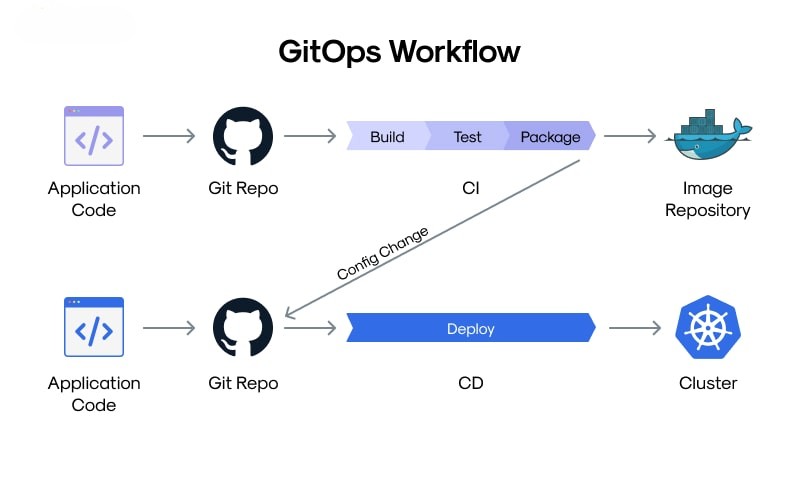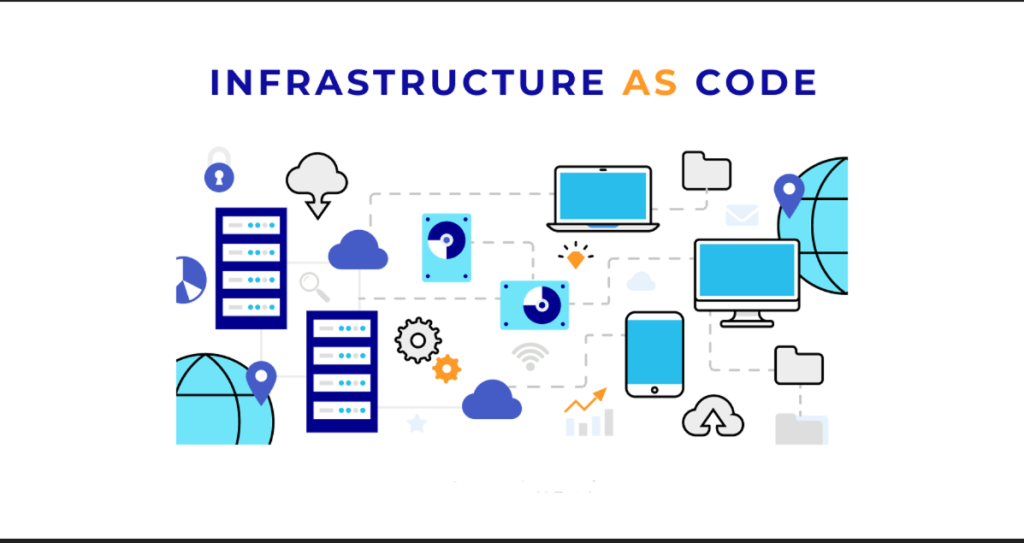
Here’s a comprehensive post titled “GitOps and IaC: How They Work Together for Continuous Deployment” with expanded content for each section:
Understanding GitOps and IaC
In the modern world of DevOps, two transformative methodologies are gaining significant traction—GitOps and Infrastructure as Code (IaC). These approaches are changing how infrastructure is managed and how software is deployed, enabling teams to embrace continuous deployment and automate infrastructure management. While both GitOps and IaC are powerful on their own, when combined, they enable fully automated workflows that improve efficiency, reduce human error, and accelerate delivery cycles.
In this post, we will explore the relationship between GitOps and IaC, demonstrating how they work together to create a streamlined, automated process for continuous deployment. We’ll also discuss the major features, tools, and benefits of using GitOps and IaC in tandem.
Key Features of GitOps and IaC
- Automation of Deployment: Both GitOps and IaC focus on automating infrastructure and application deployment, reducing manual intervention and speeding up release cycles.
- Version Control: GitOps relies on Git as a single source of truth, and IaC uses code repositories to manage infrastructure configurations, making it easy to track changes and roll back when needed.
- Consistency and Reproducibility: IaC ensures consistent infrastructure provisioning, while GitOps maintains synchronization with the desired state, making environments predictable and reproducible.
- Declarative Configuration: Both practices use declarative configuration files to define the desired state of systems, enabling automated synchronization.
- Security and Compliance: With GitOps and IaC, infrastructure and application configurations are tracked in Git repositories, ensuring better auditability and adherence to security standards.
1. What is GitOps?
GitOps is a set of practices that uses Git repositories as the central control point for deploying and managing applications and infrastructure. It relies on Git as a source of truth for both application and infrastructure configuration, automating deployment pipelines and ensuring continuous integration and continuous delivery (CI/CD).
Key Concepts of GitOps
- Git as the Source of Truth: Git repositories hold the declarative configuration files that define both the infrastructure and the application state. Any changes to these files automatically trigger updates in the infrastructure or applications.
- Continuous Deployment: GitOps automates the process of deploying infrastructure and applications, reducing the time between writing code and pushing it into production.
- Pull-based Model: GitOps uses a pull-based model where deployment tools like ArgoCD or Flux continuously monitor the Git repository for changes and pull them into the system to apply them to the infrastructure.
- Automatic Rollback: Since all configurations are stored in Git, rolling back to a previous version is easy and automated. This reduces downtime and ensures stable environments.
- Auditing and Monitoring: Changes are tracked in Git, providing visibility into who made changes, when, and why. This enhances security and auditing capabilities.

2. What is Infrastructure as Code (IaC)?
Infrastructure as Code (IaC) is a practice in which infrastructure is defined and managed through code rather than manually provisioning hardware or virtual machines. With IaC, teams use configuration files to describe their infrastructure needs, which are automatically provisioned and managed by tools like Terraform, CloudFormation, and Ansible.
Key Concepts of IaC
- Declarative Configuration: IaC enables teams to define the desired state of infrastructure through configuration files. Tools like Terraform use declarative configurations to ensure that infrastructure matches the defined state.
- Version Control for Infrastructure: Like application code, infrastructure code can be version-controlled using Git, enabling tracking of changes and ensuring consistency across environments.
- Automation of Provisioning: IaC automates the provisioning, updating, and management of infrastructure, eliminating manual steps and reducing the risk of configuration errors.
- Environment Consistency: IaC ensures that all environments (development, staging, production) are consistent by defining infrastructure through code and deploying it identically across all stages.
- Self-Healing: IaC can automatically detect when infrastructure deviates from the desired state and correct it, ensuring that the infrastructure remains reliable and predictable.
3. How GitOps and IaC Complement Each Other
While GitOps and IaC are individually powerful, when combined, they create a cohesive, automated deployment pipeline. GitOps acts as the controller for the deployment process, using Git as the single source of truth, while IaC automates the infrastructure provisioning and configuration management.
Benefits of Combining GitOps with IaC
- End-to-End Automation: IaC ensures that the infrastructure is defined and provisioned automatically, while GitOps ensures that changes to the infrastructure are automatically deployed, resulting in a fully automated deployment pipeline.
- Consistency Across Environments: IaC ensures that all environments are consistent by provisioning infrastructure as code, and GitOps ensures that all changes are applied to all environments in a uniform manner.
- Faster, More Reliable Deployments: Combining GitOps and IaC reduces deployment time and improves reliability, as every change to both applications and infrastructure is automatically validated and deployed.
- Simplified Rollbacks: With both GitOps and IaC in place, rolling back to a previous stable state is as simple as reverting changes in the Git repository. This simplifies disaster recovery and minimizes downtime.
- Unified Workflow: Developers and operations teams collaborate more easily by using Git as a unified interface for managing both application and infrastructure changes, improving productivity and reducing friction.
4. Tools for Implementing GitOps and IaC
Several tools are available to implement GitOps and IaC, making it easier for DevOps teams to automate deployments and manage infrastructure effectively. These tools integrate with Git repositories and help streamline the entire DevOps pipeline.
Popular Tools for GitOps and IaC
- Terraform: A widely used IaC tool that allows teams to define infrastructure using a declarative configuration language. It integrates well with GitOps workflows by allowing infrastructure changes to be version-controlled in Git.
- ArgoCD: A GitOps tool that synchronizes applications with their Git repositories and automatically deploys changes when configurations are updated.
- Flux: Another GitOps tool that integrates with Kubernetes to monitor Git repositories and automatically deploy changes to the infrastructure or applications.
- AWS CloudFormation: A service for managing AWS infrastructure using IaC templates written in JSON or YAML. It allows DevOps teams to define and deploy AWS resources in a version-controlled and repeatable manner.
- Helm: A package manager for Kubernetes that enables teams to define, install, and manage Kubernetes applications using declarative configuration files, often used alongside GitOps and IaC to manage Kubernetes-based infrastructure.
5. Benefits of GitOps and IaC for Continuous Deployment
The combination of GitOps and IaC brings numerous advantages to DevOps teams, especially when it comes to continuous deployment. Together, they ensure that infrastructure and applications are consistently deployed, updated, and maintained in an automated, reliable, and transparent manner.
Key Benefits for Continuous Deployment
- Continuous Integration and Deployment: GitOps and IaC enable continuous integration and continuous deployment, ensuring that infrastructure and applications are automatically updated whenever changes are pushed to the Git repository.
- Increased Agility: Teams can release new features and updates faster by automating the entire deployment pipeline, from infrastructure provisioning to application deployment.
- Improved Collaboration: Developers, operations, and security teams can collaborate more effectively by using Git as the source of truth for both infrastructure and application code, enabling transparent workflows and reducing friction.
- Reduced Errors and Downtime: By automating infrastructure and application deployments, GitOps and IaC reduce the risk of human error, resulting in more reliable and predictable deployments with minimal downtime.
- Auditability and Compliance: Since all changes are tracked in Git, GitOps and IaC ensure that infrastructure and application changes are fully auditable. This enhances security and compliance by providing a clear history of changes and access controls.
6. The Future of GitOps and IaC in Continuous Deployment
As cloud-native technologies continue to evolve, the integration of GitOps and IaC will become even more critical in managing and automating deployment pipelines. The future of these practices will see further innovations and enhancements, particularly in areas like multi-cloud environments, serverless computing, and AI-driven automation.
Future Trends in GitOps and IaC
- Serverless and GitOps: As serverless architectures become more widespread, GitOps tools will evolve to better manage serverless functions, enabling automated deployments and scaling without the need to manage underlying infrastructure.
- AI-Driven Automation: Artificial intelligence will be integrated with GitOps and IaC to predict infrastructure needs, optimize resource provisioning, and automatically scale environments based on workload patterns.
- Multi-Cloud GitOps: The future will see GitOps tools integrating more seamlessly with multiple cloud providers, enabling DevOps teams to manage deployments across hybrid and multi-cloud environments with ease.
- Enhanced Security Integration: Security will continue to be a key focus, with GitOps and IaC tools integrating more advanced security checks into the deployment process, including automated vulnerability scanning and compliance validation.
- Declarative Networking and Service Meshes: GitOps and IaC will continue to evolve to manage complex networking and service mesh configurations declaratively, ensuring efficient and scalable communication between microservices.
GitOps and IaC as Pillars of Continuous Deployment
GitOps and IaC are revolutionizing the way DevOps teams approach infrastructure and application deployment. By automating the provisioning, configuration, and deployment of both applications and infrastructure, these practices ensure faster, more reliable, and consistent delivery of software. Together, they enable continuous deployment pipelines that are automated, auditable, and scalable.
As we move forward, the integration of GitOps and IaC will only deepen, enabling teams to manage infrastructure more efficiently, reduce manual errors, and achieve faster time-to-market. By adopting GitOps and IaC, organizations can create an agile and resilient infrastructure that supports their digital transformation initiatives and provides a competitive edge in today’s fast-paced tech landscape.
